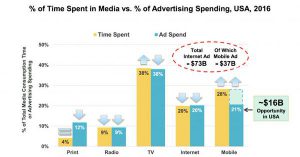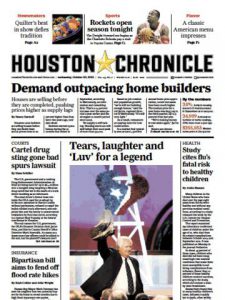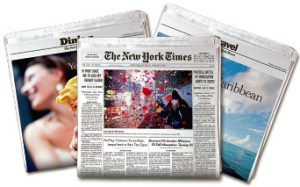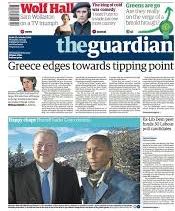Daily newspapers were the original ‘media industry’. That’s why executives are so tormented by the shredding of the news. They’ve been waiting for a grateful world to gift them a digital future. Newspaper owners – and a lot of other people too – can’t imagine a world without these legendary news brands. But they get a lot of encouragement.
The UK election campaign is the latest reminder that a whole generation of pre-digital politicians still attaches disproportionate importance to print journalism. The obsession is nurtured by the country’s TV and radio news channels which devote many hours each day to reviewing the content of newspapers and screening the front pages. So, British voters go to the polls knowing exactly how The Sun tabloid is urging its readers to vote – even though its circulation is 70% less than 25 years ago when it pompously claimed the credit for an election victory: “It’s The Sun wot won it”. But the “many see, few buy” state of UK newspapers (which actually might be missed by the millennials who never bought papers) helps to obscure the reality of their decline. They may be only in the first-stage of an increasingly painful disruption:
- Disruption 1.0: Fragmentation. The first-stage disruption was the hammer-blow fragmentation of a media market once dominated by newspapers. The technology which has given consumers more media than they can possibly consume has also given businesses virtually unlimited places to put advertising. The realisation that

“Print still gets much more advertising than it should” (source: Kleiner Perkins Global Internet Trends 2017)** print-centric media must adjust to “only” one revenue stream (like almost everyone else) is the wake-up call. But, despite Mary Meeker’s latest assertion (right) that print still gets much more advertising than is justified by its shrinking share of audience time, publishers are in denial. Many of the UK’s national dailies are, for example, currently inflating their circulation figures by up to 20% with free copies, in vain efforts to compete for those vanishing ad revenues. They can’t get their heads or spreadsheets round the fact that spoilt-for-choice readers will increasingly pay only for distinctive content not for the freely-available general news. But that low-value news stubbornly continues to dominates the content – and costs – of most daily newspapers.
The future winners will be those able to exploit the increasingly clear distinction between two broad types of competitive media: 1) Free, mass-market content funded by advertising or sponsorship. 2) Reader-funded content without (any or much) advertising. All types of media (whether in print, digital or broadcast) will be able to thrive as either type of media. Only a small number of exceptional brands will be able to straddle the two.
End of the news ‘department store’
For most, it will be the end of daily newspapers as “department stores” of news, information and entertainment – and of sky-high staffing levels funded by once-booming advertising revenues. If they don’t narrow their focus and concentrate on exploiting distinctive content like political analysis, these traditional news brands risk losing out to digital specialists like the burgeoning Politico in the US and Europe. Sport is another area of traditional newspaper content that risks being lost to specialist providers if newspaper brands don’t give readers the opportunity to buy it separately from the ‘bundle’. It is all part of the need for these print-based ‘product producers’ seriously to become multi-channel ‘service providers’.
But they need a new business model and a fundamentally different approach to costs. The daily newspapers’ traditional luxury of paying for multiple sources – staff, contributors and news agencies – to provide even freely-available general news coverage must come to a grinding halt, along with their out-dated approach to selecting content for publication only after it has been produced. There’s nothing wrong with providing

general low-value, non-exclusive news to complement high-value exclusive content – as long as you don’t expect readers to pay much for it. The increasingly inefficient system of casual street sales of newspapers will also disappear along with many of the retailers which once depended on them: only subscriptions and membership will make sense for paid-for news, whether in print or digital. Having a direct relationship with (and data on) readers is valuable whether or not you sell advertising. But the cost squeeze will intensify as these legacy businesses try to hang on to readers that may – for a long time yet – be inconveniently and expensively divided between print and digital.
- Disruption 2.0: Newscasting. Next comes the accelerating video competition for traditional news brands which have already been struggling to keep up with the smartphone news of low-cost, digital-only operators. The increasingly global TV news channels will upstage most newspapers which are already behind the pace in the consumer demand for video and (coming soon) virtual reality. Moreover, the rapid growth in on-demand TV viewing will help the news-only channels to capture large audiences that have long been ‘locked-up’ by the news bulletins of mass market television networks. So, mass audiences that want news in video and on-demand will not be coming back to newspaper-like content, whether in print or online. But there’s worse.
The news disruption may be accelerated by the growth of voice-activated technology like Amazon’s Echo, Google Home and Apple’s HomePod. These “smart speakers” this week drew the fire of WPP boss Martin Sorrell who identified them as a new threat to the advertising industry. In practice, they will be challenging all media channels. Echo et al will soon offer all kinds of content at the expense of the media brands that have already been air-brushed by social media. Consumers will be able to choose scheduled ‘push services’ like wake-up news bulletins, podcasts, sports news and weather reports via these speakers. Perhaps music will be meshed into it too, to create personalised radio to compete with streamers and broadcasters. Jeff Bezos’s learnings from the Washington Post will not be wasted in this birth of Newscasting. On-demand audio and video could squeeze the life out of all but the best news brands. But the disruption won’t stop there.
- Disruption 3.0: Journopreneurs. Newspaper executives make much of the supposed risk to the survival of high-value journalism posed by the decline of print. But the rapid growth of not-for-profit digital services – and the reader-revenue success of political magazines and digital ‘explainer’ journalism – is helping to disprove that. Easy-to-use, low-cost tech and the loud-hailer of social media are creating a boom in small-scale, citizen and home-made journalism. But a coming explosion in high-quality blogging and free or low-cost journalism will attack newspaper-centric businesses from all too familiar sources: their own journalists.
These news companies find themselves out-paced by digital rivals whose tech-savvy teams are younger and leaner. For all the salami-slice cost-cutting of recent years (many with staff reductions averaging 50%), most daily newspapers are still heavily over-staffed. The unrelenting squeeze on revenues will ultimately force newspapers to lay-off large numbers of experienced journalists and, as a result, expose themselves to an explosion of Journopreneurs. Blogs, news services and ‘push’ emails everywhere will effectively be funded by newspapers’ severance payments. The legacy news brands will unwittingly be funding their next competitors.
As a result, news will become a much smaller business than it is now. But there will still be plenty of it. The independent provision of news – whether local, national or global – is not going to disappear, even though some of its most profligate providers will.
More than just cost-cutting
It is a whole decade since former Harvard professor Clark Gilbert first urged newspaper companies to separate new digital operations from their traditional businesses, before successfully putting his “dual transformation” theories to work at Deseret Media. Gilbert was proving the point that the quite distinct streams of new and old media require different people, skills, investment horizons and – in each case – single-minded management. The important takeaway was the need for a new plan, not merely a tweak of an old one. The search for a new business model is so much more than merely cutting costs. Of course.
It is clear that the likely winners among major newspaper publishers will be those with the unswerving support of long-term shareholders – and/or alternative businesses to fill the gap left by the loss of news revenues. Prominent among these will be a global clutch of family-controlled companies which are busy digitalising away from the print businesses that had once made them rich and powerful.
Hearst: what disruption?
The world’s first media company was created 130 years ago in 1887 when (William) Randolph Hearst transformed his single San Francisco newspaper into a media company with the acquisition of newspapers, magazines and pioneering

movie and newsreel productions. Sixty-six years after his death, the company has become a post-digital role model with more than 360 businesses and 20,000 employees in 130 countries.
From being a company once known primarily for its newspapers and global magazines like Cosmopolitan, Hearst now makes far more profit from its fast-growing business-to-business information companies. It generates high-value data, analytics and software for the healthcare, finance and automotive industries and utilities around the world. Its largest company is the 80%-owned Fitch credit ratings group.
But Hearst still makes more of its profit from broadcasting than anything else, which includes substantial earnings from shareholdings in businesses managed by its hand-picked partners. It has more than 30 television stations such as WCVB in Boston and KCRA in Sacramento, reaching almost 20% of US homes. Its long-established A+E Networks JV with Disney has the cable TV channels A+E, History, Lifetime, Crime & Investigation, Biography, and Vice Media’s new Viceland.
These highly profitable TV interests have often been dwarfed, though, by Hearst’s 20% share of the Disney-controlled ESPN, long the world’s most successful sports cable network. Over the past 25 years, ESPN has thrown off huge amounts of cash for its owners. Some years, it has generated 50% of Hearst’s total profit (a role now taken on by Fitch, just as ESPN itself fights decline).
As Hearst redoubles its efforts to find fresh businesses that will transform profitability like magazines and cable TV once did, its investment policy may shift in the direction of the acquisition of Complex Media (50m monthly uniques and 300m monthly video views) by a Hearst joint venture with the US broadband-telco Verizon. Ever since its initial stake 21 years ago in the once-dominant Netscape, Hearst has been one of the most successful media-tech corporate investors with more than $1bn invested in companies including: BuzzFeed, Vice, HootSuite, Caavo, LiveSafe, Roku, Science Inc, LiveSafe, Stylus, Swirl, and MobiTV. It’s a great talent spotter in more ways than one.
Buried somewhere in the glowing testimony of high-growth media is Hearst’s original newspaper business which now has the lowest profit among the company’s media divisions. But the quietly reinvented business is doing better than most of its peers. With more than 4,000 employees, it publishes 17 dailies and 57 weeklies in Texas, California, and New York state. Its local digital services have also grown by an average of 14% for the last four years and have more than 30m monthly uniques. The real achievement of this legacy business, however, is that Houston Chronicle, has become one of the world’s most profitable daily newspapers. The figures are closely guarded but the 115-year-old daily may be making profits of more than $60m – or over 50% of all the profit made by Hearst’s 70+ newspapers.
What is the largest newspaper in Texas and the sixth-largest newspaper in the US has successfully developed into a multi-media company producing a portfolio of print and online products serving Houston’s diverse audiences, in English and Spanish. The Houston Chronicle has successfully built and maintained its market leadership by building paid-for as well as free distribution businesses, as follows:

- The paid-for flagship daily complemented by local weeklies and branded editions.
- A market-leading free web site (Chron) which is distinct from the paid-for site for newspaper subscribers.
More than anything else, the two-site strategy is a neat (and obvious when you think about it) way to out-compete the digital-only competition while building a strong digital presence for subscribers for whom the paid-for web site (with its 1m paying viewers) is a bridge from print to digital.
The Houston Chronicle performance is crucial to Hearst’s newspaper group which, despite its shrinking importance to the parent company, grew 2016 profits for the fifth consecutive year. Hearst Corp total revenues last year were some $10.8bn. Although that revenue was only 1% up on 2015, it has grown by 140% in the past decade. Even the realisation that the numbers are flattered by revenues from the $2bn spent on acquisitions during the year, serves to underline the powering reinvention of a media group whose pre-tax profits are now more than $1bn. For all the disruption of its once-dominant print businesses, the so-versatile Hearst has scarcely missed a beat.
News Corp: ‘the other business’
Rupert Murdoch was the successor to Randolph Hearst as a fearsome global media strategist. But more so. He used his once-booming newspapers in Australia, the UK and US to build a conglomerate in movies, books, digital services and TV.
Murdoch’s two public companies, News Corp and 21st Century Fox, have a combined market value of $58bn. But the value of News Corp is scarcely a tenth of the total value of the two companies which together were known as News

Corporation, until the 2013 demerger. The company now includes Harper Collins book publishing, Foxtel Pay TV in Australia, US coupon distribution, Dow Jones Newswires, the Wall Street Journal, and largely loss-making metropolitan and national daily newspapers in its three core countries.
News Corp has revenues of some $8bn, almost 25% of which are derived from the Australian, British and American newspapers. But profits tell a different story. The newspaper losses are obscured in the company’s accounts by its powering US coupon company. This company, the digital real estate media (primarily REA in Australia and Move Inc in the US) and book publishing accounts for all the News Corp profit – and all its growth.
These powering businesses, especially the property media (with revenue up 13% in the past year) has provided cover for the core newspapers which are now starting to deliver the required shift to digital subscriptions:
- Wall Street Journal subscribers are now 53% digital and are up 44% in the past year to an average 1.2m.
- The Australian newspapers have increased digital subs by 27% to 333,400
- The switch in The London Times to three editions daily seems to be paying off with viewership up almost 40% on its smartphone app. The Times and Sunday Times now have 185,000 digital subscribers. The Times is launching The Brief, a premium website and subscriber events for legal readers. It signals a new area of paid-for expansion which, in the future, might include B2B vertical media targeting professionals in politics, culture, property and retailing.
- The Sun’s (now free) digital service reached more than 80m global uniques in March 2017 – up from 36m. This growth, alongside the interesting UK acquisition of TalkSport radio, shows that The Sun could soon be head-to-head with BuzzFeed and Daily Mail Online.
News Corp shares its Murdoch family senior management with 21st Century Fox but News Corp is their ‘other business’ and, despite Rupert Murdoch’s own sentimental attachment, newspapers are right at the bottom of the pile for his sons and heirs who are, increasingly, in charge.
New York Times: ‘all the services fit to test’
The New York Times is the whole business, not a reducing priority in a media conglomerate. It illustrates, therefore, what can be done with an endlessly patient and focused owner. A newspaper that was once all print and mostly casual street-sale readers in the US is now seen to be strongly subscriptions, increasingly digital and global. The company, which now has 3.2m subscribers (2.2m digital) had $399m of revenue in the first quarter of 2017,

including a stunning 400k subscribers to the daily crossword puzzle.
So, it is that Arthur Ochs Sulzberger, the newspaper’s third-generation family majority shareholder, told Wired magazine of his plan to make digital subscriptions the main engine of a billion-dollar business, inspired by Netflix and Spotify. The company was investing in its core journalism while adding new online services and features (from personalized fitness advice and interactive newsbots to virtual reality films) so that a subscription became indispensable to paying subscribers in the US and internationally.
The milestones are impressive:
- In the first quarter of this year, it added 308k digital-only news subs. Circulation revenue from digital-only subscriptions increased by 40% to $75.8m. Its online site has some 90m monthly uniques.
- “The Daily,” the newspaper’s brilliant daily podcast, introduced in February, already has more than 27m downloads and streams and is on track to exceed 100m this year. Many expect the launch of a business version of the podcast during 2017.
- The New York Times now has 13m email subscribers – doubled in three years, on the back of no fewer than 5o newsletters “pushed” to subscribers on a wide range of subjects. These newsletter subscribers are twice as likely as regular readers to become subscribers, and they read twice as many stories per month as the average newspaper reader.
- The newspaper is about to launch its next big paid-for product: Cooking, a three-year-old hitherto free app and site that currently has 10m monthly uniques. Readers will be able to get 10 free stories per month before having to pay up. Only a small proportion of Cooking’s bank of 17,000 recipes and articles will still be freely available and readers will also have to pay for a time-saving “Your Recipe Box” feature.
Many newspapers (and not just in the US) have benefitted from a rise in readership as a result of the almost daily comments of President Trump, ironically their harshest critic. His tweets and speeches have created huge volumes of news traffic. They have helped the New York Times to grow an international online audience, alongside its print edition (formerly known as the International Herald Tribune).
But the innovations show that New York’s favourite broadsheet is fast becoming much more than a news provider. Its historic slogan “All the News that’s Fit to Print” might almost become “All the services fit to be tested”.
Washington Post: no billionaire’s toy
The 2013 announcement that Amazon founder Jeff Bezos had acquired the legendary Washington Post from the Graham family for $250m was exciting news for forlorn newspaper industry executives and for reporters who dusted off their anecdotes about how Lehman Brothers (yes) had once predicted Amazon would go bust. The deal was a thunderbolt for US media which reacted as if, well, Donald Trump had bought the Smithsonian or the British Museum.
Once the dust had settled, it became clear that, however much the investment seemed very small in relation to Bezos’s $50bn+ fortune, Washington Post would not be a mere plaything for the billionaire who has invested in everything

from space travel to Uber, Business Insider, and Fundbox. The man whose fusion of e-commerce and content has arguably re-defined not just retailing but also media, has been serious in his time-efficient way of searching for solutions to the seemingly terminal problems of daily newspapers. And he has been enthusiastically investing in the expansion of staff and resources. Last year, it started to pay off.
The Washington Post claimed to have become America’s fourth national newspaper, joining the New York Times, the Wall Street Journal and USA Today, to have added 60 journalists (8%), and, most striking of all, to have become profitable for the first time in a decade. It increased subscribers by 75% and says it has doubled digital subs revenue. It also doubled its overall readership in print and online. Bezos is distinctly hands-off when it comes to content and editorials but his fingerprints are all over a strategy that has 80 techies working alongside the paper’s 750 journalists, to produce huge amounts of video, print and digital content.
For the newspaper that made its modern reputation by exposing the Watergate presidential scandal in the 1970s, the Washington Post is making the most of its opportunity with Trump. Reporting has been expanded, not least with a quick-response investigative team, 62 different newsletters and big investment in mobile video and audio/podcasts (built on the success of its 44-episode presidential podcast series). The Post is all over the stories the world is following from Washington and the site has some 80m monthly uniques.
The newspaper, though, is very much still a work in progress. Bezos has ensured his people are working all the time to maximise download speeds and a range of other tech issues. Although Bezos owns the newspaper privately, it is not just Amazon’s launch into video streaming that brings his two main business interests so close together. Recently, the Post signed its biggest contract to sell web publishing tools, mostly hosted by Amazon. The deal, with the Los Angeles Times-parent company, is a boost for the profitable, year-old service, Arc Publishing, which now has 12 clients.
The approach to making money out of tools originally built for internal use, is reminiscent of what Amazon did with the data centres that now form the backbone of Amazon Web Services (AWS). The deal benefits AWS, the world’s biggest cloud-computing business and Amazon’s fastest-growing division, which last year grew sales by 55% to $12.2bn. Arc is a neat opportunity to extend into publishing. Alongside Washington Post subs offers to Prime subscribers, it may also point the way towards a global push for the news brand itself. Alexa and Amazon Prime: you’re going to be in the news business.
Schibsted: who guessed?
The Oslo-based company, whose newspapers Verdens Gang and Aftenposten have long been dominant in Norway and Sweden, is the global media success few could have predicted. Schibsted has been a public company since 1989 but its independence is protected by a family trust which remains the largest shareholder.
These past 10 years, the 178-year-old company has dazzled its peers by gutsily using its newspaper platform to a build a world-class digital business. It has moved fast to strengthen its existing businesses and faster still to launch new ones. The strategy came from Rolv Erik Ryssdal who became CEO in 2009.

Schibsted has growing newspapers-magazines-books-TV operations in Estonia, France, and Spain and nearly-global online businesses. It was, arguably, the first significant newspaper company to realise the potential of becoming the digital disruptor in markets where it had no legacy business to defend. The company now employs 7,000 people in 30 countries across three continents. Last year it increased revenue by 13%, with profit margins reaching 19%. More than 70% is now digital revenue, and digital classifieds grew by 17% in the first quarter this year. It also owns 41% of the 20 Minutes free newspapers in Switzerland, France and Spain.
The vitality of Schibsted can be gauged by two recent successes:
- Shpock (“shop in your pocket”), the ‘flea market app’, has more than tripled to 41m downloads and 12m active monthly users in the past 18 months, principally in Austria, Germany, Italy, the UK, Norway and Sweden. It is on the way to becoming a serious challenger for eBay.
- VGTV, the video channel spun-off from the leading Norwegian daily, now produces more revenue than the seven-day newspaper itself. In 2016, the 70-person VGTV generated $10m, and increased revenues by 51% during the first quarter of 2017 from daily unique audiences of 420k. That and also advertising was up almost 30%. VGTV is getting almost 1m video views – in Norway, which has a population of only 5m. This increasingly effective monetisation of TV-like online video news looks like a perfect role model for media groups everywhere. Especially those, like Schibsted, which realise that the success has been turbocharged by its separation from the newspaper which spawned it.
These fast-moving initiatives are part of the next wave of growth for the once small Scandinavian company that has become such a global force, increasingly head-to-head with its near neighbour in Germany.
Axel Springer: living the dream
The Berlin-based publisher of Die Welt and Bild recently reported EBITDA profit up by 17%, revenues up 7%. It is now generating 80% of its profits from digital and 50% of its revenues from international markets including the US where it has become one of the most active investors in Silicon Valley startups. Axel Springer is living the dream of newspaper-centric businesses everywhere.

As recently as 2009, the Berlin-based company seemed like any other troubled newspaper group whose sliding print advertising and circulation revenues had slashed EBITDA profits by almost 40%. The publisher, which 15 years ago was described by the Financial Times as “an internet midget”, is now a hyper-active 21st century digital media company.
It is 71 years since Springer was founded in Hamburg by Heinrich Springer and his son Axel, with the launch of the TV listings magazine Horzu and acquisition of the newspaper Hamburger Abendblatt. Their prestige and profitability were transformed by the 1952 launch of Bild, based on Alfred Harmsworth’s pioneering British tabloid, the Daily Mirror. But Bild (“Picture”) became more raunchy and politically right-wing. It has long been one of the world’s largest-selling dailies and is still Europe’s leader, with almost 2m circulation – even after a 50% decline in the past seven years.
Axel Springer founder died in 1985. His company’s controlling shareholder is his fifth wife, Friede Springer. The newly-public company lurched from one crisis to another in the 15 years following its founder’s death, with a succession of bosses and disastrous strategies. Then, along came its unlikely saviour, Mathias Döpfner. Having studied musicology, literature and theatre science in Frankfurt and Boston, the 6ft 7 inch-tall editor began his career in 1982 as the music critic of the Frankfurter Allgemeine Zeitung. After working as a news correspondent in Brussels – and also as manager of the Winderstein concert agency – he moved to Gruner + Jahr in 1992.
Four years later, he became editor-in-chief of the tabloid Hamburger Morgenpost. In 1998, he joined Axel Springer as editor-in-chief of Die Welt, its prestigious – but seldom profitable – national daily. He sharply reduced its losses. Within four years, the seemingly unambitious Döpfner found himself propelled into the Springer senior management. He became chief executive in 2002. It was the year after the company managed to make losses of €200m. He set about cutting costs and, in 2004, increased Springer profits by 23%. He also managed to rid the company of its hostile 40% shareholder, the former TV entrepreneur Leo Kirch. Friede Springer now controls 57% of the public company’s shares.
In 2016, Springer made EBITDA profit of €0.6bn (+6.5%) on revenues of €3.3bn (+4% underlying). Profit margin was 18% from some strong performances:
- World-leading position in digital classifieds for jobs, homes and vacation rentals, especially in Germany, UK, South Africa and France. These revenues are growing organically at 12% and generating profit margins of 21.5%.
- Growing paid-for international media. Business Insider (a mix of free and paid-for services) was acquired for a heady $450m in 2015 – on the rebound from Springer’s abortive bid to buy the Financial Times. The 50% increase in revenues so far this year – and a 30% growth in video views – indicates the gamble is starting to pay off. In just 10 years, BI has grown from a three-person tech blog to an increasingly global news organization reaching a claimed 300m people each month. Springer may have similar ambitions for its mobile news aggregator Upday available across Europe exclusively on Samsung devices.
- Some 430k digital subscriptions for its two German daily newspapers.
- Its adventurous investment strategy in startups including as a major shareholder, alongside Discovery Communications, in Group Nine Media, a millennial portfolio which claims 3.5bn monthly video views. It also has a 50% share of the Brussels-based Politico Europe, which has 1.5m monthly uniques and a weekly print magazine.
The €6bn company has tripled its value in the past 15 years. The expansion underlines how Springer (like Schibsted) has been able to grow new digital business best by expanding in markets where it had no traditional media to defend. These companies have worked out how to become the disruptors.
Fairfax: Out of the fire
The publisher of the Sydney Morning Herald (SMH), The (Melbourne) Age and the Australian Financial Review – is the archetypal story of newspaper decline. For decades, Aussies looking for a house, car or job in the country’s two biggest cities only had to go to the two most profitable and prestigious broadsheet newspapers, the SMH and The Age. Weekend

editions once weighed 2kg, some of the heaviest papers published anywhere.
The long-term print classified success bred a familiar complacency. After the inevitable collapse, Fairfax has been widely criticised for passing up early, low-cost opportunities to own what are now Australia’s leading digitals in motors (CarSales), homes (REA), and jobs (Seek). Fairfax executives in the 1990s voted for the continuing supremacy of their print classifieds (once described enviously by Rupert Murdoch as “rivers of gold”) and passed up repeated chances to take control of the emerging digital companies.
The Fairfax brush-off left the startups to be funded, instead, variously by Lachlan Murdoch and James Packer. The fact that those three digital companies together now have almost 10 times the value of Fairfax Media is the well-publicised “revenge” for the new generation of the families which had long fought to control the 17-year-old newspaper group.
Fairfax’s painful recovery from those sleepy “print classifieds will never die” days are now marked by its own high-performing online property site Domain launched from the Sydney Morning Herald to become the no.2 to the News Corp-controlled REA.
It has been estimated that Domain, as a stand-alone site, would be worth more than the value of Fairfax as a whole, which is why the troubled parent company now finds itself the subject of competing private equity bids. The bidders are appetised by the view that the online property success would be greater still if unencumbered by print operations.
Flakey strategies and investor pressure had led Fairfax openly to flirt with the possibility of scrapping its printed newspapers – until someone did the calculations. Having come to their senses and reaffirmed the continuation of print for some years yet, the next Fairfax plan was to propose an IPO for the Domain site. That would have enriched shareholders but left the company with seemingly with only a half-share in a radio group as offering any growth prospects at all. Predictably, the Domain spin-off plan provoked the private equity bids, from the US-based firms TPG Capital and Hellman & Friedman (whose boss is a former chairman of Fairfax).
It might all have been so different. The A$1.9bn Fairfax Media might have been in the same position as Hearst, News Corp, Schibsted et al. But the founding family lost control in 1990 when an errant 26-year-old son son leveraged the business into bankruptcy. The upshot was a succession of ownership tussles involving disgraced Canadian proprietor Conrad Black, Aussie media mogul Kerry Packer, and mining heiress Gina Rinehart. Twenty-five years of contested ownership, abortive mergers, bungled acquisitions, and six different CEOs would have been challenge enough for a traditional news group even without digital disruption and the loss of its classified wealth. Fairfax had it all.
The once towering media group has found itself under continual pressure from impatient shareholders, who have despaired of the strategic zig-zags. Despite having made more than 2,000 redundancies in the past seven years, the company still looks flabby. Observers cannot understand why Fairfax finds itself unable to make any kind of sustained profit from, say, the 100,000 daily newspaper sales each of the Sydney Morning Herald and The Age (with cover prices of A$2.80 and A$4.40 respectively). As elsewhere, there are even richer pickings at the weekend, and that’s before counting the revenue from pretty impressive digital audiences. If Fairfax can’t make the Australian Financial Review profitable with 50,000 daily sales at A$4.40, surely someone else will. But that will now be down to the sharp-pencilled whizzes of private equity. A few years of private ownership might now, perversely, give these legendary news brands the opportunity of reinvention away from the glare. Just like the others.
Protected by family trusts
These positive developments at family/trust-controlled news companies (sort of) reflect what Clark Gilbert was saying about the need for traditional media to concentrate on its core relationships, unencumbered by the new digital opportunities. What once were newspaper groups have used their power, profits and audience platforms to create substantial new media businesses. Protected from short-term pressures by dynastic shareholding arrangements and alternative growth businesses, these once great news companies are free to experiment in order to maximise opportunities in a shrinking industry.
Other news companies may be able to secure a future, not least in partnerships with broadcasters, tech companies or digital-only news services. Some might become charities. But it will be a very different news business. The clue is in the way that the ‘news’, which once was the main focus of all these companies, is now mostly way-down the pecking order.
So you’re English…
As the ‘inventor’ of national daily newspapers, the UK may again provide some stand-out retreats from global strategies that always seemed to make too much of their supposed ‘advantage’ of the English language. That is how it seems for two more quite dissimilar UK family-trust controlled media companies.
It is exactly 10 years since The Guardian became the first to roll-out a global news strategy which always seemed more a philosophy than a business

plan. The free-spending expansion (subsidised by windfall profits from non-newspaper investments) started in the United States where then-editor Alan Rusbridger built a considerable editorial reputation with his award-winning coverage of Wikileaks and Edward Snowden. But his New York office, along with an Australia base, may soon become spectacular casualties of The Guardian’s life-saving campaign to halt its £100m annual cash burn – and ensure its survival. Or they may be hived off to the punchy Vice News, with whom The Guardian now has a TV joint venture.
The ads-funded global online strategy never made sense for the charity-owned news brand that (even now) could become safely profitable and reader-funded if it gives up the world and gets back to concentrating on the UK, where it has more than 100,000 paying (something) members. It might even generate ancillary worldwide digital subs revenue without really trying. The trouble is that, even in its most profitable, print-only days, The Guardian was never a major display advertising medium (most of its ads came from jobs classifieds). How could it have expected to do any better across the world in the digital-ravaged 21st century?
But The Guardian is far from the only British newspaper to have wasted money on hubristic, global dreams.
The family-controlled Daily Mail & General Trust (DMGT, founded 120 years ago by tabloid pioneer Alfred Harmsworth, ancestor of the current chairman and controlling shareholder) earns the majority of its profits from high-performing international B2B media, notably in the US. In that sense, it has secured its future. But the company remains best-known for the Daily Mail, the vociferous mid-market tabloid which is still one of the UK’s most profitable dailies alongside its best-read daily, the Metro free tabloid. This is the legacy news business that the DMGT parent group has expanded away from.
Mail Online boasts a mighty 240m monthly audience for its racy, showbiz-focused news service, which shares the branding but little else with a newspaper that still scares British governments to death. Mail Online has digital teams in London, New York, Sydney and Los Angeles, which pump out 1,200 pieces of content and 800 videos a day. It gets some 1.5bn mobile impressions daily. But the lengthening list of controversies, claims and inaccuracies is clearly hampering its commercial development in ways that underline the difference between a national news service and a global one. It is no exaggeration to say that some UK politicians would be simply too frightened to complain about hostile coverage in the Daily Mail. There’s no such apprehension, of course, in the US and Australia.
The controversies (highlighted by an expensive settlement recently with one Melania Trump) are keeping some advertisers away, in print and online. It is more than five years since Mail Online’s promised breakeven date came and went, amid staffing levels that are much more Fleet Street than BuzzFeed. And Jonah Peretti gets a lot more revenue. The Mail just doesn’t get it.
After 14 years of losses, DMGT (which, memorably, hung on to its UK regional newspapers long enough to lose almost £900m on their eventual sale) might just make a gilded escape from global online news and, perhaps, from the whole of its declining news business. Its claim to have “the world’s largest newspaper web site” is a good selling point, whatever the losses. Divestment could more than pay-off DMGT’s £700m of borrowings, create a war-chest for long-term B2B acquisitions and give shareholders something to smile about. Just watch.
Have you read?
Why newspapers must dare NOT to be daily
The ‘secret’ business of Schibsted
Have you signed up yet?




